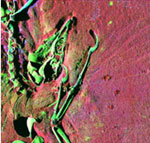Archaeopteryx Feathers and Bone Chemistry Fully Revealed via Synchrotron
Imaging
summary written by Raven Hanna
Archaeopteryx, the half-reptilian, half-avian creature that lived 150 million years ago is famous as the fossil record's link between dinosaurs and birds. The discovery of the first Archaeopteryx fossil, which coincided with the publication of Charles Darwin's On the Origin of Species, provided strong evidence of the theory of evolution. Because Archaeopteryx fossils are important and rare, no samples have been taken for standard chemical analysis, which is a destructive process.
A research team including scientists from SLAC, the University of Manchester, and the Black Hills Institute of Geological Research used SSRL Beam Line 6-2 to analyze the chemical composition of a well-preserved Archaeopteryx fossil. They used the non-destructive technique Synchrotron Rapid Scanning- X-ray Fluorescence (SRS-XRF) imaging to analyze the presence of trace elements in the fossilized bone compared to the surrounding rock. They found that the zinc and copper levels in the fossilized bone are similar to those found in living bird species. Using a novel form of the SRS-XRF technique, the researchers were able to visualize phosphorous and sulfur in the feather shaft impressions in the fossil, showing that, contrary to expectations, some of the chemistry of the soft-tissue has been preserved.
The researchers point to the power of the SRS-XRF technique to find evidence of
ancient biochemistry. The technique could be used on other fossils that have
not been removed from the surrounding rock. This work was published online by
the Proceedings of the National Academy of Sciences on May 11, 2010.
To learn more about this research see the full Scientific Highlight
U. Bergmann, R. W. Morton, P. L. Manning, W. I. Sellers, S. Farrar, K. G. Huntley, R. A. Wogelius, and P. Larson (2010) "Archaeopteryx feathers and bone chemistry fully revealed via synchrotron imaging," Proceedings of the National Academy of Sciences, published online May 11, 2010; doi: 10.1073/pnas.1001569107


